This guide describes the general Technical Review process for a typical project.
Note: The technical review process described in this guide is generalized and is not intended to capture the process entirely. The process can vary between projects and you should ask your project manager about the specific review processes that apply to the course you are working on.
Prerequisites
Before you proceed complete the following:
Topics in this guide
- How a technical review is initiated
- Steps required to conduct a technical review
- Key points about the technical review process
How a technical review is initiated
A content author initiates a review by sending an email to the reviewer to request a review. The author’s email provides the following details:
- Module number: The module number that the file for review belongs to.
- Task type: The type of review required (i.e. technical review, instructional design review, copy edit, etc.).
- Source branch name: The name of the branch that the file for review is on. This is also referred to as the compare or originating branch.
- Target branch: The name of the branch that the corrected/ changed file will be merged into, after the review is completed. This is also referred to as the base branch, and is typically the master branch.
Note: A content author develops content on their own authoring branch, with a separate authoring branch for each module. Authoring branches use the naming convention
m <module number> auth <author's surname>, where:
- The prefix
mis for “module”.<module number>refers to the module number that the file to be reviewed belongs to.authis a short code for “content authoring” i.e. the stage in the process the file is at.- The author’s
<surname>is added as a suffix to distinguish the author’s work from other contributors.Example authoring branch name
The following explains how the example authoring branch name
m6authleeis constructed.
mis an abbreviation for “module”.6is the number of the module that the file belongs to.authis a short code for “content authoring”.leeis a reference to the author’s surname.Putting the previous items together results in the authoring branch name
m6authlee.
Steps required to conduct a technical review
The following steps are required to conduct a general technical review as part of a typical project.
-
When you receive an email from a content author requesting a review, note the name of the authoring/ originating branch to be reviewed.
-
Access the file(s) to be reviewed on GitHub by following the guide View course files in web browser.
-
On GitHub, open a new Pull Request (PR) by using the guide Create pull request.
Note: Keep the new PR open (i.e. do not merge the PR), to allow the content author/ originating branch owner to apply any changes necessitated by the review. Configure the pull request by following the remaining steps in this guide.
General information about pull requests is available from the guide Pull requests overview.
-
On the GitHub page Open a pull request, use the dropdowns to configure the PR branches as follows:
- For base, choose the master branch
- For compare, select the name of the originating authoring branch, e.g. m6authlee
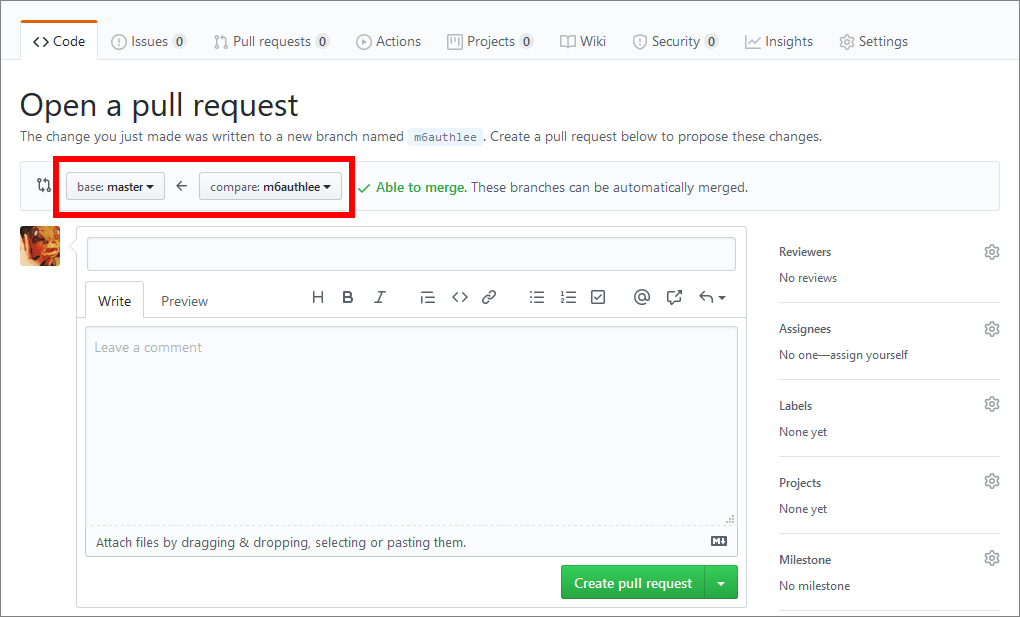
-
On the GitHub page Open a pull request, add the following information into the PR title text field:
- prefix [Do not merge]
- number of the module that the file under review belongs to
- type of review you are conducting (e.g. technical review, instructional design, etc.)
- name of the compare/ originating authoring branch to merge from
- name of the base/ target branch to merge into
The following provides an example of a suitable PR title as: [Do not merge] Mod 6 Tech Review of m6authlee merge into master
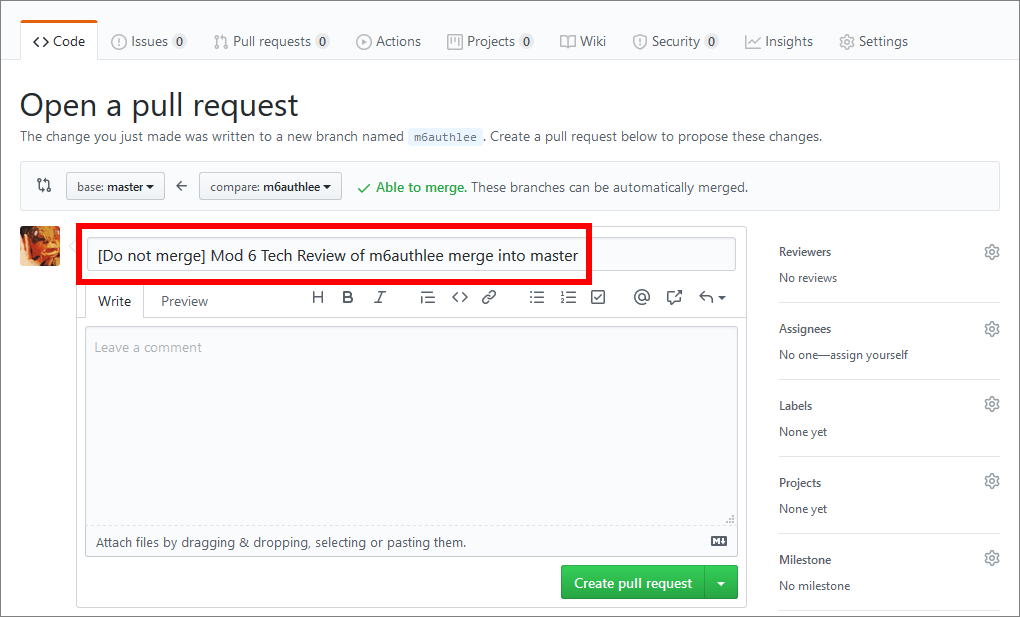
-
On the GitHub page Open a pull request, in the Write tab, add a checklist for each item in the file to be reviewed by using the following markdown syntax.
- [ ] Tech Review Complete - [ ] Tech Review Complete - Lesson 1 - [ ] Tech Review Issues Resolved - Lesson 1 - [ ] Tech Review Complete - Lesson 2 - [ ] Tech Review Issues Resolved - Lesson 2 - [ ] Tech Review Complete - Lesson 3 - [ ] Tech Review Issues Resolved - Lesson 3 - [ ] Tech Review Complete - Lesson 4 - [ ] Tech Review Issues Resolved - Lesson 4 - [ ] Tech Review Complete - Lab - [ ] Tech Review Issues Resolved - Lab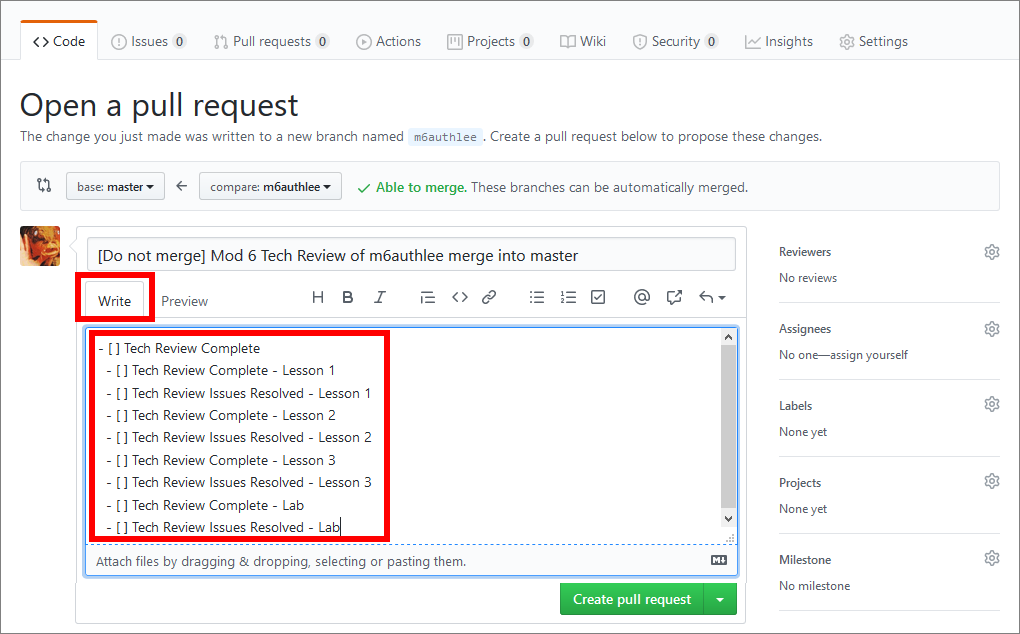
Note: Work with the content author to determine the items to be reviewed, like the number of topics or lessons the file under review contains. Each topic, lesson or component of content that the file contains can be added as an item to the checklist in GitHub.
-
On the GitHub page Open a pull request, choose Create pull request.
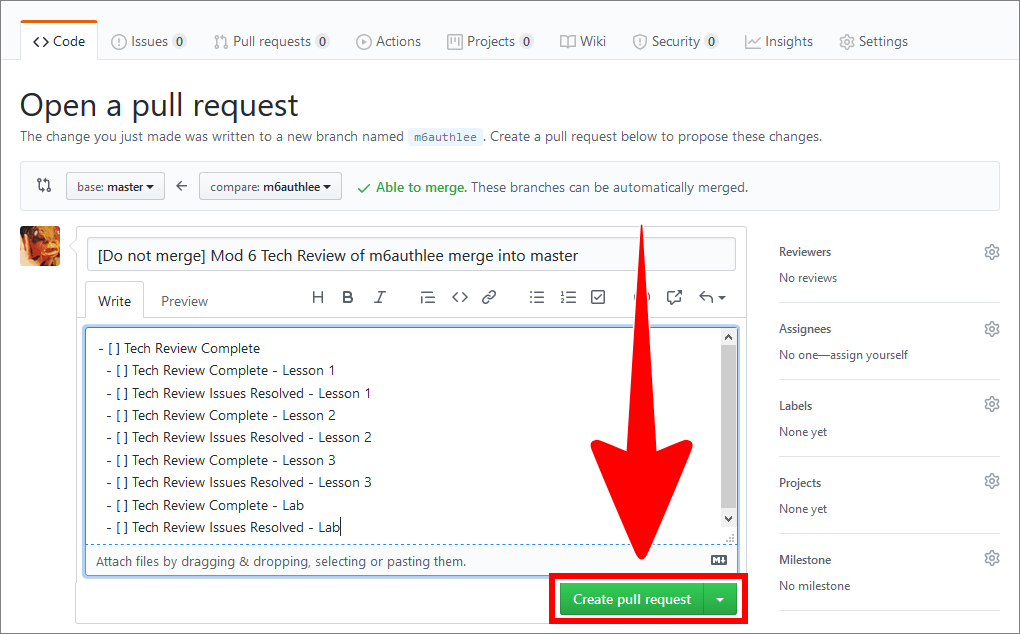
-
Review the contents of the file(s) on the originating branch for technical accuracy in accordance with WayPoint Ventures’ technical review guidelines.
-
Keep a record of any proposed corrections/ changes to the content.
-
Notify the content author of any required changes to the content.
-
Work with the content author to determine which proposed corrections are to be applied to the content.
-
When you and the content author have determined the corrections/ changes to be applied, allow the content author sufficient time to:
- apply the necessary changes to the content on their originating/ authoring branch (in VSC).
- push their corrected/ changed content back to the project’s GitHub repo.
- notify you that the corrected/ changed content is available from the project’s GitHub repo.
-
When the author notifies you that corrections have been applied to an item on the checklist, review the updated content. If a checklist item passes technical review, update the item’s corresponding checkbox (in the pull request Conversation tab on GitHub) to indicate that the item was addressed and passed.
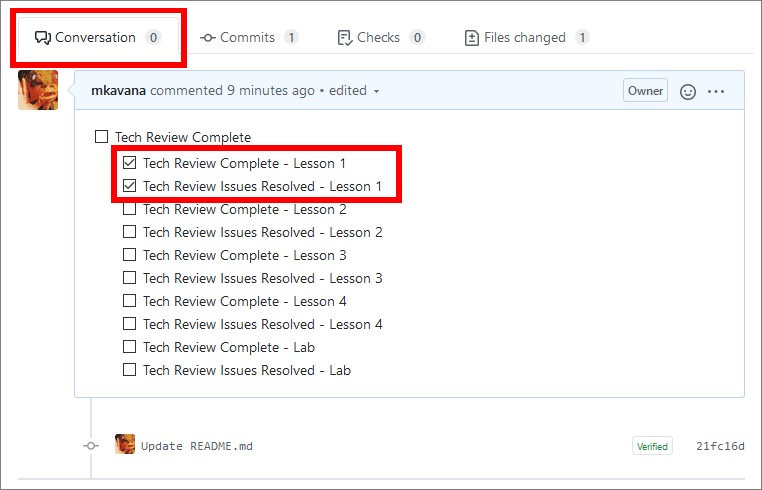
-
Repeat Step 8 to 13 until all of the checklist items are addressed and the content passes technical review.
-
When the content passes technical review, in the pull request Conversation tab on GitHub, use the checkbox to indicate that the full technical review has been completed successfully.
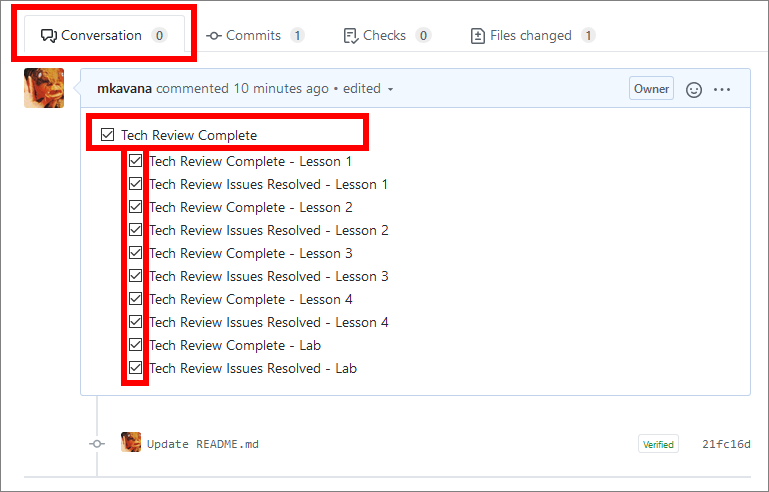
-
In the pull request page on GitHub, confirm that the this branch has no conflicts with the base branch message is shown, then select Merge pull request.
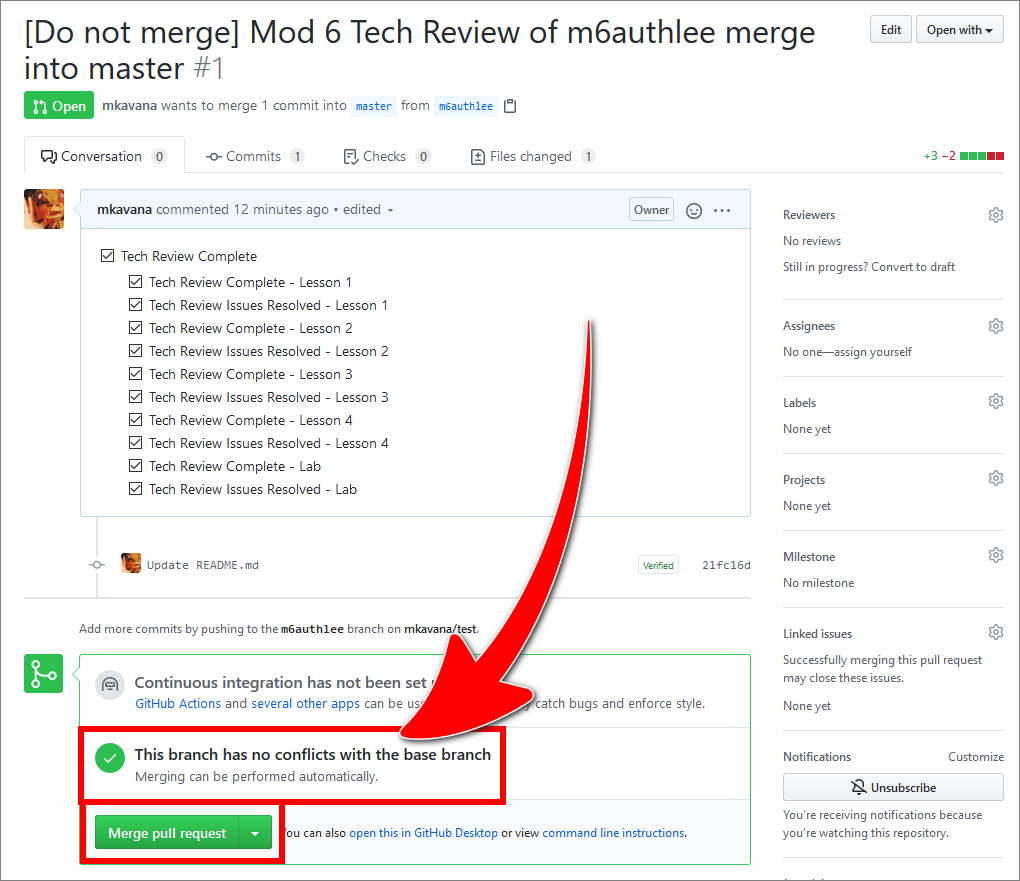
Note: If GitHub indicates that there are conflicts, follow the guide Resolve merge conflicts to address any outstanding merge issues, and then try merging the pull request again.
-
In the pull request page on GitHub, choose Confirm merge to merge the originating branch back into the master branch on the project’s GitHub repo.
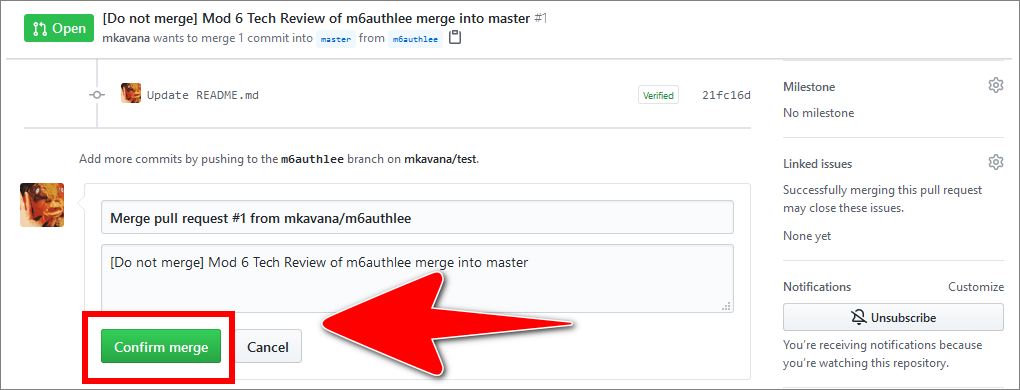
-
The Pull request successfully merged and closed message on GitHub indicates that you have merged the PR successfully.
Note: Do not delete the originating authoring branch.
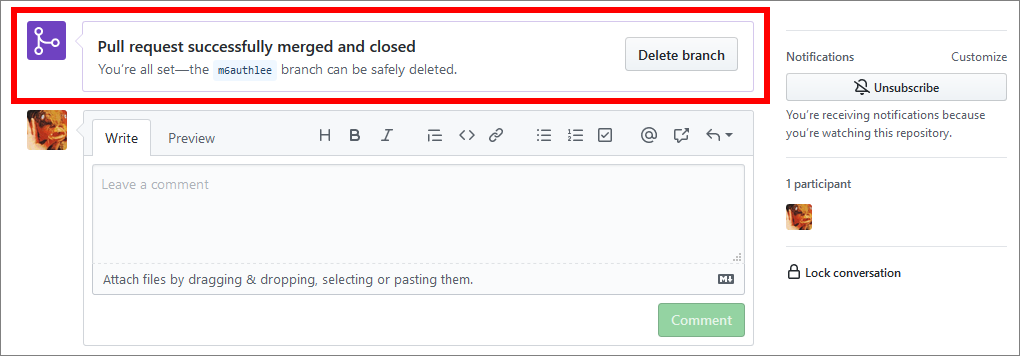
Key points about the technical review process
The following are key points about the technical review process.
- A content author requests a review by sending an email to the reviewer.
- The technical reviewer:
- receives an author’s email requesting a review.
- opens a new GitHub Pull Request (PR).
- sets the PR compare branch to the originating branch.
- sets the PR base branch to master.
- adds the prefix [Do not merge] text, and a suitable description, to the PR title.
- creates a checklist of items to be addressed.
- keeps the PR open (i.e. does not merge the PR) to allow the author to apply changes during the review.
- reviews the contents of the file(s) on the originating branch.
- records any proposed changes to the content in the PR.
- notifies the originating branch owner of any required changes to the content.
- The content author/ originating branch owner:
- works through the corrections/ changes proposed by the reviewer.
- applies any necessary changes to the content on their originating branch (in VSC).
- pushes the corrected/ changed content back to the project’s GitHub repo.
- notifies the reviewer that the corrected/ changed content is available from the remote repo.
- The technical reviewer and content author work together to identify, agree upon, and add required corrections/ changes to the PR, until the content passes technical review successfully.
- When the content passes technical review, the technical reviewer merges the originating branch back into the master branch on the project’s GitHub repo.
The following diagram provides an overview of the key points in the general technical review process for a typical project.
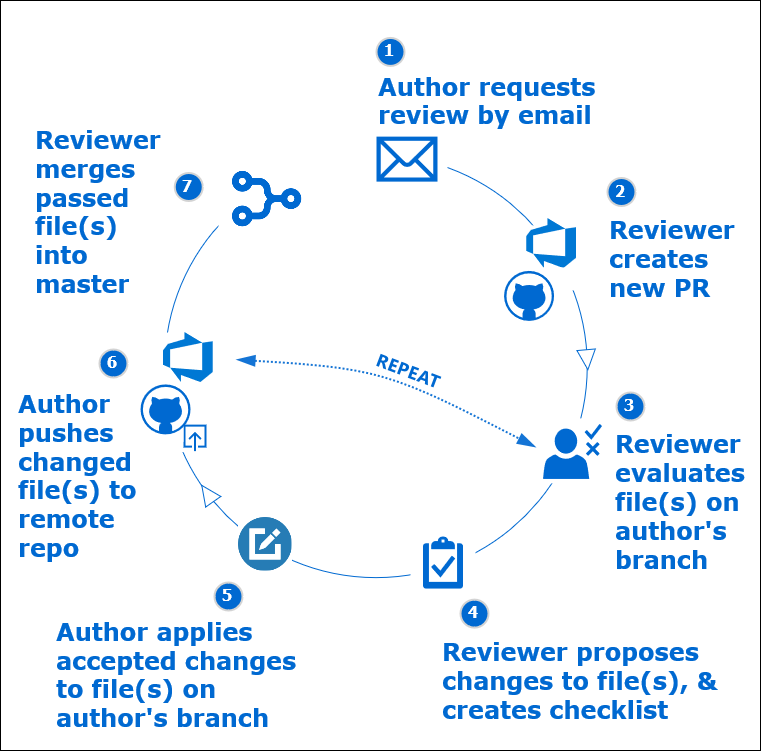
Appendices
Check the following supplementary Appendices for more details and context.
